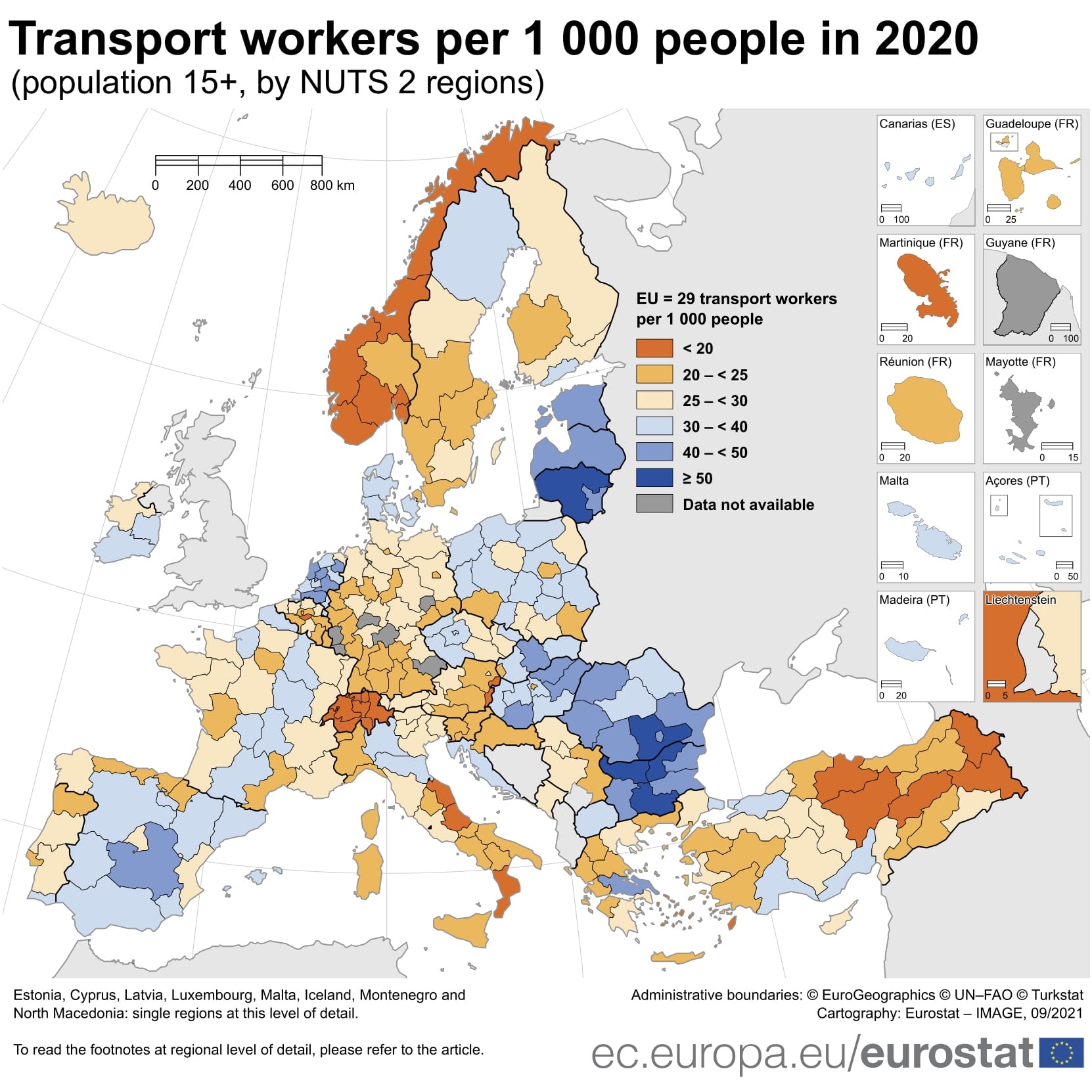In 2020, 10.8 million people aged over 15 were employed in transport occupations in the EU. The number went down by 6% compared with 2019 (11.6 million).
These transport jobs include heavy truck and bus drivers (35% of people employed in transport occupations), transport and storage labourers (22%), car, van and motorcycle drivers (19%), messengers, package deliverers, luggage porters and other elementary workers (12%), refuse workers (5%), locomotive engine drivers and related workers (3%) and travel attendants, conductors and guides (3%).
Among transport jobs, conductors and guides registered the largest drop in employment in 2020 (-16% in the number of people employed compared with 2019), followed by transport and storage labourers (-11%).
Source: EU Labour Force Survey special data extraction and lfst_r_lfsd2pwn
The vast majority of the transport workers were men (85%). Over one third of people employed in transport occupations in the EU were 50 years old or over (37%) or 35 to 49 years old (36%). On the other hand, a slightly lower share of them were aged less than 35 (29%).
Spotlight on transport workers across the EU regions
In 2020, on average, there were 29 transport workers per 1 000 people in the EU, however, this rate varied across the regions. The highest rates were generally recorded in the south-eastern regions of the EU, with South-Muntenia in Romania on the top with 65 transport workers per 1 000 people.
South-Muntenia was followed by three Bulgarian regions: North-West (58), North-Central (54), South-Central (51), as well as Central and Western Region in Lithuania (51).

Source: EU Labour Force Survey special data extraction and lfst_r_lfsd2pwn
In contrast, Walloon Brabant in Belgium recorded the lowest rate of transport workers per 1 000 people (15), closely followed by South Aegean in Greece (16), ahead of Burgenland in Austria and Melilla in Spain (both 18) as well as Calabria in Italy (19).
For more information:
- To know more about recent developments in passenger and freight transport, you can visit the dedicated section on transport statistics.
- Transport occupations in this article, as defined by the ISCO-08 classification, include: 511 - Travel attendants, conductors and guides, 831 - Locomotive engine drivers and related workers, 832 - Car, van and motorcycle drivers, 833 - Heavy truck and bus drivers, 933 - Transport and storage labourers, 961 - Refuse workers and 962 - Messengers, package deliverers, luggage porters and other elementary workers.
- In this article, the region of residence of the workers is considered and regional data are presented at NUTS 2 level. Estonia, Cyprus, Latvia, Luxembourg, Malta, Iceland, Montenegro and North Macedonia: single regions at this level of detail.
- Regional data with low reliability: Freiburg (DE13), Tübingen (DE14), Oberpfalz (DE23), Oberfranken (DE24), Mittelfranken (DE25), Swabia (DE27), Hamburg (DE60), Kassel (DE73), Mecklenburg-Western Pomerania (DE80), Braunschweig (DE91), Detmold (DEA4), Koblenz (DEB1), Dresden (DED2), Chemnitz (DED4), Ceuta (ES63), Melilla (ES64), Corsica (FRM0), Guadeloupe (FRY1), Martinique (FRY2), Valle d’Aosta (ITC2), Burgenland (AT11), Hedmark and Oppland (NO02), Trøndelag (NO06), Northern Norway (NO07), Ticino (CH07).
- Regional data not available due to very low reliability: Lower Bavaria (DE22), Unterfranken (DE26), Bremen (DE50), Giessen (DE72), Trier (DEB2), Saarland (DEC0), Leipzig (DED5), French Guiana (FRY3), Åland Islands (FI20).
- Data not available: Mayotte (FRY5).
- In this article, the names of the regions are in English.
- In Germany, since the first quarter of 2020, the Labour Force Survey (LFS) has been integrated into the newly designed German microcensus as a subsample. Unfortunately, for the LFS, technical issues and the COVID-19 crisis have had a large impact on the data collection processes, resulting in low response rates and a biased sample. The published German data are preliminary and may be revised in the future. For more information, see here.
To contact us, please visit our User Support page.
For press queries, please contact our Media Support.


